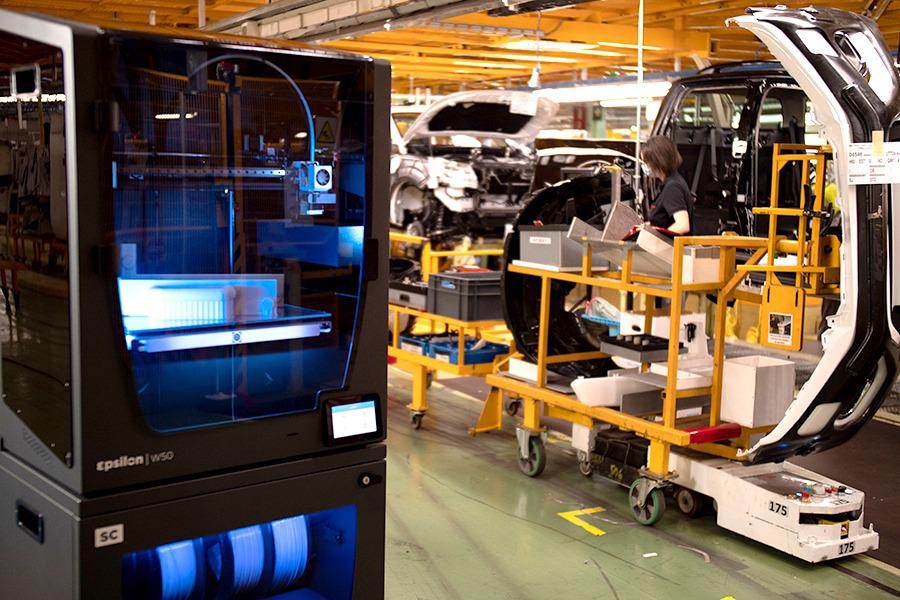Nissan’s factory in Barcelona is using 3D printed equipment and fixtures throughout its assembly line saving time and money.

Image Credit: BCN3D.com
Automotive giant Nissan has teamed with Spanish 3D printing solutions expert BCN3D¹ in a pilot scheme that may see the use of 3D printing adopted in its production lines across the globe. The pilot project was conducted at the car manufacturer’s Barcelona-based factory.
BCN3D provided the location’s production line with its 3D Fused Filament Fabrication (3D FFF), which could be used to create tools, jigs and fixtures. The results in terms of both having time and expense have been impressive enough for the car giant to consider a worldwide roll-out.
A digital walkthrough of the Nissan assembly line -3D printed tools, jigs and fixtures
Thus far the process has been used to manufacture 700 parts at the stunningly low cost of as little as 3.45 Euros or just over 4 USD. The parts were also created in under 24 hours. Until now Nissan has outsourced the creation of prototype parts to suppliers who rely on traditional manufacturing techniques, but this could change that practice.
The upside is that this has resulted in high-quality parts, the downside is it comes at long and inflexible creation times and the process comes in at a relatively high financial cost with even the machining for basic tools costing as much as 400 Euros, roughly 480 USD.
Thankfully, whilst turning to 3D printing seems to have massively cut these costs and reduced manufacture lead times by a significant amount, the change doesn’t seem to have impacted the quality of the end product. In fact, the Nissan team based in Barcelona switched its entire design process to 3D printing and discovered it to be more straightforward than traditional mechanical alternatives.
The performance achieved in terms of reliability has been excellent. Our printer runs nearly 24 hours a day and every year we are printing around 100 different jigs and tools for specific use in our processes. Outsourcing tools to a mechanical supplier was 20 times more expensive than 3D printing the same parts, whilst the wait for tools went from a week down to one day.
Carlos Rellán Martínez, Manager of Maintenance & Engineering facilities, Nissan
Could 3D printing revolutionize the automotive industry?
Nissan equipped its additive manufacturing lab with four BCN3D supplied printers, which can constantly operate over a 24 hour period. One of the significant benefits of these particular machines is that they can simultaneously produce two identical parts.
The car manufacturer is also employing a recently devised BCN3D ‘smart cabinet’ which can print filaments in a way that increases their shelf life and radically reduces defects, limiting the necessity for costly reprints.
Nissan isn’t the first car manufacturer to begin experimenting with 3D in its production lines, of course. Even with such technology in its relative youth, 3D printing is already having a marked positive effect on how automobiles are manufactured.
Until recently, the main application of 3D printing in the industry has been for fast prototyping, but this has now expanded to the manufacture of final end-use car parts. Industry insiders expect the value of just this single aspect of the 3D printing market to reach as much as 9 billion USD by 2029.
Volkswagen, BMW and Ford are the companies leading the way in the application of 3D printing in the production of automobiles. 3D FFF itself, as adopted by Nissan has become one of the most frequently used 3D printing technologies selected by car manufacturers. Part of the reason for this is this technique can be applied to a range of different materials.
This means that car manufacturers may maintain continuity in production whilst granting independence from external suppliers, the net effect of which is the streamlining of the production process.
Racing Ahead with 3D Printing
The use of 3D printing has already allowed for the creation of some extraordinary motor vehicles. In 2019, Polish students from AGH University of Science and Technology unveiled the AGH Racing — RTE 2.0, an electric racing car consisting of a multitude of 3D printed elements.
In addition, the fire trucks created by BOCAR², use 3D printing to create sub-assembly prototypes from plastics. The manufacturer has refined the process, which utilizes a 3DGence INDUSTRY F340 printer shortening the creation lead time by several months.
The ready cast created by the suppliers of equipment for fire brigades removes the need for manual welding of several vehicle components and results in hydraulics with reduced failure rates and boosted accuracy.
It’s little wonder that so many car manufacturers are increasingly turning towards this technology and away from traditional manufacturing. And Nissan seems to be planning to be a part of this revolution. Something that already seems to be paying dividends.
The pilot scheme saw the creation of a range of tools, including devices to repair machines that place windshields, a drill positioning machine and a jig that positions and cures a car’s model name on its body.
By introducing 3D printing, we have increased added value and generated low costs, without high delivery times. We have paid off the investment in the printers very quickly.
Carlos Rellán Martínez
Disclaimer: The views expressed here are those of the author expressed in their private capacity and do not necessarily represent the views of AZoM.com Limited T/A AZoNetwork the owner and operator of this website. This disclaimer forms part of the Terms and conditions of use of this website.